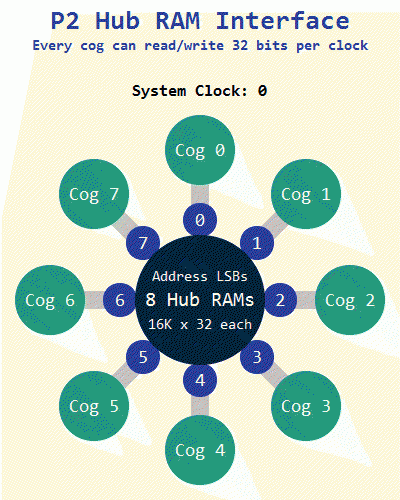
|

|
Forum Index : Microcontroller and PC projects : CMM2: It is actually easy to hand-solder the 176-pin ARM CPU...
| Author | Message | ||||
| Tinine Guru Joined: 30/03/2016 Location: United KingdomPosts: 1646 |
While it's true that the worst case scenario is that a cog has to wait 16 clocks to access the hub (the old P1 only), you wouldn't do this for super time critical operations. Each cog has a local 2K (496 longs) of memory. The Prop supports mixed memory models: My_time_critical_routine COG 'This will launch in a cog and never access the hub '@80MHz this executes 20MIPS Do waitpeq state, mask 'execution halted until pin equals (waiting fast) 'alternatively waitpne (not equal) ' do whatever, after the pin equals the mask Loop For other non critical code, you specify LMM (large memory) instead of COG to utilise the hub. If you need faster than 1/20,000,000 sec, you need the P2  |
||||
| Tinine Guru Joined: 30/03/2016 Location: United KingdomPosts: 1646 |
 |
||||
Grogster Admin Group Joined: 31/12/2012 Location: New ZealandPosts: 9757 |
I remember the Prop.  I bought a couple of "Propeller Backpack" modules, as they were able to generate either VGA, or it was possibly actually composite video. I think it was the latter. The idea being that I could use the prop BP, to generate the video, as you could control it with serial commands. I think I posted a thread here about that years and years ago. Interesting discussion, and the prop is an interesting chip.  I myself, won't be going back to the prop, simply cos the new PicoMite VGA does colour VGA out of the box(which is crisper then composite video anyway), and is perfect for what I want it for - just simple text-based, but colour, information output for a system I have in mind. See a thread about this that I will be posting very shortly...... Smoke makes things work. When the smoke gets out, it stops! |
||||
| Mixtel90 Guru Joined: 05/10/2019 Location: United KingdomPosts: 8298 |
@flasherror I've used a simple USB microscope for SMD work. It feels a bit strange looking at the monitor while your hands are elsewhere though! You don't *have* to have 3D but I think it would probably be much easier to see what's happening. It was beyond my price range though. It's easy to get a microscope with way too much magnification. You don't want anything more than x20 for soldering. Even x10 will be enough in some cases. Maybe up to x40 for final inspection. Mick Zilog Inside! nascom.info for Nascom & Gemini Preliminary MMBasic docs & my PCB designs |
||||
| Tinine Guru Joined: 30/03/2016 Location: United KingdomPosts: 1646 |
Yeah, it was VGA, actually  The Micromite Companion Mini Computer It was how I learned of the existence of MMBasic and what inspired me to use a Micromite to command my own Prop developments. One heck of a combo. Unfortunately, Jeff Ledger just up and vanished from the Prop community and some of his own site links went dead. Picomite Companion, anyone? There was also a Pi Hat with the P1 but I guess there wasn't enough interest. :( Craig Edit: I just located and downloaded the software and firmware  Edited 2022-02-11 22:09 by Tinine |
||||
| lew247 Guru Joined: 23/12/2015 Location: United KingdomPosts: 1702 |
Is there much difference in ProbBasic to MMBasic? |
||||
| Tinine Guru Joined: 30/03/2016 Location: United KingdomPosts: 1646 |
No it's child's play. The beauty of it is that; it is literally a translator to PASM (Propeller Assembly). You use BASIC syntax and compile it. You then get a PASM listing and it's a direct one-for-one translation. Where I show "waitpeq" in the above listing? It's actually a PASM instruction. The DO-LOOP? In some cases I use GOTO instead because it translates, literally to a PASM jmp. A DO-LOOP generates more overhead. I refer to PropBasic as "PASM-RAD" because it's more like Rapid Application Development for Propeller assembly. Now we have TWO options: 1) PropBasic 2) FlexBasic FlexBasic is the newer, more-refined option and works on both P1 and P2. The cool thing here is that FlexBasic is a member of the FlexProp suite and supports mixed languages. If there is a C function or a Spin method (Prop's native language) that you need in your FlexBasic code, just declare it as a class and it will compile with the Basic code. On the P1, I still have an affinity for PropBasic and haven't thus far tested FlexBasic on that device but I use FlexBasic on the P2. P1 or P2, it's only a compiler directive that is selected from a menu. Craig |
||||
| Tinine Guru Joined: 30/03/2016 Location: United KingdomPosts: 1646 |
@lew247 To avoid a misunderstanding, I should clarify that the Prop in no-way competes with or substitutes for MMBasic....for me. I find the two to be a dream-team: MMBasic: Management Propeller: Workforce Regards, Craig |
||||
| The Back Shed's forum code is written, and hosted, in Australia. | © JAQ Software 2025 |